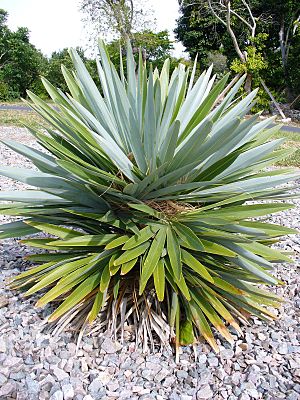Hemithrinax ekmaniana facts for kids
Quick facts for kids Hemithrinax ekmaniana |
|
|---|---|
 |
|
| Conservation status | |
| Scientific classification | |
| Genus: |
Hemithrinax
|
| Species: |
ekmaniana
|
| Synonyms | |
|
Thrinax ekmaniana (Burret) Borhidi & O.Muñiz |
|
The Hemithrinax ekmaniana is a special type of palm tree. It is found only in one place in the world: Cuba. This means it is an endemic species. Sadly, there are fewer than 100 of these adult palm trees left in the wild. This makes it a very rare and endangered plant.
Contents
Where the Jumagua Palm Lives
This unique palm tree grows only in the Mogotes de Jumagua area in northern Cuba. Mogotes are like small, steep, rounded hills made of limestone. The Hemithrinax ekmaniana palm was thought to be lost until it was found again in 1978. A group of paleontologists (scientists who study fossils) and naturalists (scientists who study nature) rediscovered it. They were exploring caves and listing the plants and animals in these small mountains. Today, these palms still cling to the steep cliffs of just three of these mogotes.
What the Jumagua Palm Looks Like
The Jumagua palm has a gray trunk that is about 5 centimeters (2 inches) wide. At the top, it has a round and very thick crown of leaves. These leaves are stiff and spiky, with a light green color. They grow very close together because they have almost no stalks. This gives the palm a very dense and compact look.
Growing the Jumagua Palm in Gardens
In 1996, experts collected seeds from these rare palms. They wanted to help protect the species. These seeds were grown into new plants that are now found in several Botanical Gardens around the world. You can see specimens of the Jumagua palm at:
- The Montgomery Botanical Center in Miami, USA
- The Palmetum de Santa Cruz in the Canary Islands, Spain
- The Orto botanico di Messina in Italy
- The Jardín Botánico de Las Tunas in Cuba
For a long time, you couldn't buy this plant. But in 2007, seeds collected from the wild were sold for the first time. This allowed many plant growers in different parts of the world to get them. This helps spread the plant and protect it from disappearing completely.
See also
 In Spanish: Palmitas de Jumagua para niños
In Spanish: Palmitas de Jumagua para niños


